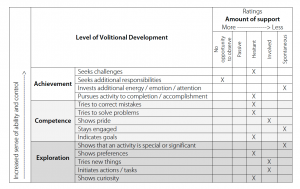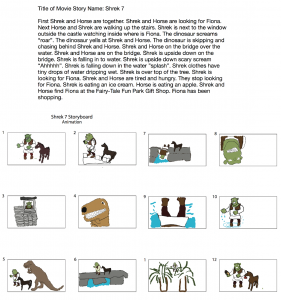CASE STUDY
Post School options for a student who has high wandering tendencies were limited. Those trialed continued to have safety issues. This information was provided to NDIS to support additional funding. The MOHO questionnaire has been formatted for this particular report.

The student is happy to sit and work for hours at a time when provided with tasks. When left in a group situation where there is insufficient supervision or insufficient interest in the content there is greater risk of absconding. This has happened all the way throughout school and the student did abscond from school. The student does not attempt to abscond from home, ever. As a younger child the student attempted to abscond from the family when out in public. There have been no attempts to abscond from the parents care since early High School.
These are some of the tasks that the student, now post school is able to do with 1:1 support and individualised instructions:
University programming – Graphic Arts degree – auditing one subject (family pays for the subject, parent attended and completed the coursework for themselves at the same time with long term aim of setting up a family business to be able to do graphic design work commercially where the parent ran the business and their loved on completed the work tasks that they were able to):

The student achieved a PASS mark for the entire subject. The parent achieved a much higher mark. The following semester was attempted and was walked away from as an entire concept of attending the University as the workload fluctuations and lack of consistency in the structure of the work were taking a significant physical toll on the parent. They also had a student completing year 12 to support. The parent and therapist had spent considerable amount of time going through each subject content before applying for each subject. Others made recommendations about the sequencing of subjects which conflicted with the Occupational Therapists recommendations. The student is now completing home programming with the same pathway for work place options being considered. Progress has been considerable as the flexibility in how their NDIS funding is allowed to be used has allowed for 2 hours per week of Occupational Therapy throughout the year. Request for planning and programming time was requested from NDIS given the industry wide issues which were documented and the safety and emotional / physical toll issues on the parent / family was documented yet this was not approved. The report was 64 pages long and provided research articles for support. The initial review only provided for the 1 hour per week of funding for OT with some hours for carer support which still then required both the therapist and parent considerable workload to prepare work for the carer to sit down and complete. This was done within a University library in a private room where the student could get used to being around others whilst learning to remain seated with the goal of completing work independently without absconding so that the carer could leave the room to use the bathroom etc. The parent was required to remain in the library to ensure that when the carer went to the toilet that her loved one was actively remaining seated within the same room for the time period that the carer was gone. This was achieved through use of FaceTime so that the parent was talking to or watching their loved one the entire time.. This worked well. Covid changed everything and that part of the programming was stopped.
Examples of the past few years of content since finishing school:
Formatted version of the Assessment of Communication and Interaction Skills (ACIS) 4.0
” _______’s poor comprehension of language and context requires him to visually monitor what is happening around him within interactions. During small group interactions he watches facial expressions to get additional information about the emotional tone and content of the conversation. _______ finds it challenging to shift his attention rapidly between the task, his motor actions and the non-verbal communication that comes from the therapist when providing him with greater information to support success / instruction with what he is doing / needing help with. ________ can focus intently on a verbal conversation being directed at him and attend to facial expressions and follow the content (visibly observable to others his comprehension). His difficulty spatially understanding tasks and the details of placement within task because of his lack of skill with categorising steps / knowledge base requires the therapist to use a lot of non-verbal cues with smaller sentences spoken so that looking up at the therapist is not necessary so that he does not become overwhelmed and can learn faster.”
The student expresses a lot of direct anger to the therapist when asked if he would like more of something and is happy to sit for hours without moving when given task after task after task after task. His current progress with home based therapy is that he is showing substantially less anger towards recurrent tasks being completed together and is able to recognise more changes that he can make within his own home routine where he is showing greater variety and depth of the content that he is actively CHOOSING to participate in HIMSELF without prompting or any guidance other than previous tasks having been learnt / explored and the tasks on offer having been modified. High level interests include: magazines, car racing, motor bike racing, iPad gaming. The student is now actively playing with his younger post school sibling on Nintendo and Xbox for long periods of time together cooperatively.